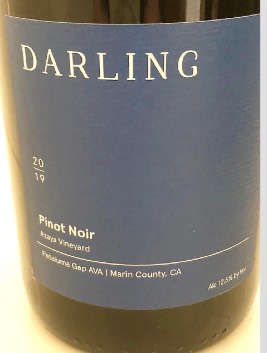PinotFile: 12.16 March 21, 2021
|
Tasting Pinot Noir Virtually
Basically, a package of wines is offered for sale and sent to the consumer who can then sample them while guided by a host. There is no charge to those who purchase the wines. Most virtual tastings can also be accessed without buying the wines for no or a small charge. Here are some virtual Pinot Noir tastings that are worth looking into.
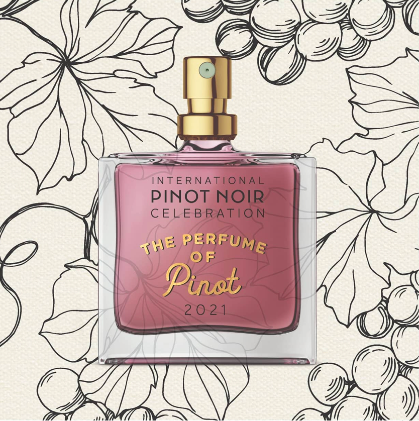 35th Annual International Pinot Noir Celebration The granddaddy of all Pinot Noir events is going virtual beginning July 14, 2021. Only 100 Virtual IPNC packages are offered: 18 bottles of premium Pinot Noir wines shipped to your home; a live Grand Seminar titled “The Perfume of Pinot” with a panel of wine legends and luminaries with wines shipped to your home; two University of Pinot classes of your choice; cooking demos and recipes from award-winning Pacific Northwest chefs. All-inclusive packages are priced at $995. Visit www.ipnc.org for information and tickets. Oregon Pinot Podcast The International Pinot Noir Celebration is presenting a series of online conversations with winemakers and wine professional from around the world. A carefully selected four-pack of wine is available for purchase to accompany the broadcast ($175). A donation of $20 is required to attend if the fourpack of wine is not purchased. Episode 8 will be on March 20, 2021 and is titled, “The Hand of the Winemaker,” Focusing on Oregon Chardonnay. Visit www.ipnc.org for more information. Adelsheim Founders’ Stories This series of conversations with the 10 founding wine families of Oregon’s North Willamette Valley is available for viewing on the Adelsheim website at www.adelsheim.com/ 50years#founders. Adelsheim is celebrating its 50th anniversary of what became their first vineyard. The series began in March and features David Adelsheim sitting down, one-on-one, with each of the original founders to talk candidly about the collaboration and formation of the Willamette Valley wine industry over the last 50 years. Chapter 1, “The Eyrie Vineyards” with Diana Lett and David Adelsheim is available for viewing now. The full interviews are available by subscribing to “Founders’ Stories: The Podcast,” offering the ability to hear new episodes as soon as they are released. Also, a full-length, hour-long video conversation will be available to view through the Oregon Wine History Archive at www.oregonwinehistoryarchive.org. Commemorative wines will be offered by Adelsheim or look ahead to the episodes and pull a wine or two from your cellar produced by the featured founder’s winery.
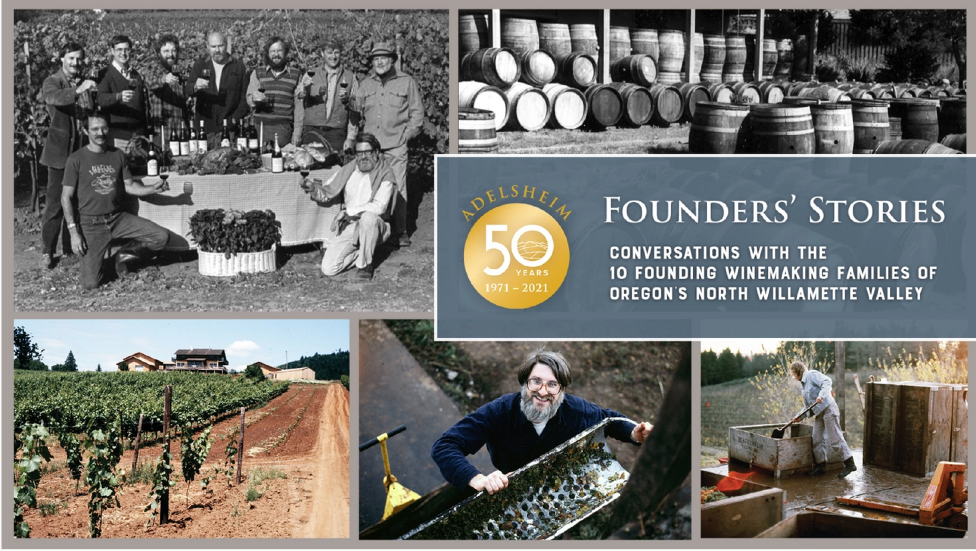 West Sonoma Coast Vintners This association of wineries (26) and growers who farm along the mountainous coastline of western Sonoma County offer WSC Live! every Wednesday at 4:30 PDT on Instagram. Each week a different winery principal from the West Sonoma Coast will take the stage with a winemaking friend of theirs to have a fun, lively conversation. Go to www.instagram.com/westsonomacoast by browser or phone and click on the “LIVE” button at the top left of the screen next to stories. Past installments are available at www.westsonomacoast.com. Knudsen Vineyards Second generation managing partner, Page Knudsen Cowles, is hosting a virtual tasting and conversation as she shares the history, innovation and experimentation that put Knudsen Vineyards in the forefront of recognized vineyards in the Willamette Valley. A virtual tasting and wine kit consisting of one bottle each of 2016 Knudsen Pinot Noir, 2018 Knudsen Backstory Pinot Noir and 2018 Knudsen Chardonnay can be acquired prior to the April 16 event. Must RSVP by April 1. Visit www.knudsenvineyards.com. The Outlook from Knudsen Vineyards A virtual interview series on ZOOM began March 9, 2021 celebrating 50 years. The lineup: March 9 Dick Erath, April 13 Rollin Soles, May 11 Alison & Alex Sokol Blosser, June 8 Veronique Boss-Drouhin, July 13 Allen & Jackson Holstein, and August 10 Brian Croser. Registration and viewing is free. Visit www.knudsenvineyards.com. World of Pinot Noir Virtual Seminars Connect with WOPN’s wineries and winemakers through a virtual experience. Seminars continue through the end of March. Visit www.worldofpinotnoir.com.
For an extensive listing of virtual wine tastings available visit www.businessinsider.com/best-virtual-winetastings. com. Of course, those on winery mailing lists will receive invitations to join in for virtual tastings. I don’t see this trend ending when the pandemic wanes because highly personal virtual contact between consumer and producer is a very powerful marketing tool.
Cattleya: A Woman’s Touch
The one impression I did develop over the years is that women tend to have a “touch” with Pinot Noir. Their discriminating palates allow them to bring out a sense of balance in winemaking that you don’t always see with men. Historians agree that wine was most likely discovered by a woman. Liz Thach, Ph.D., in an article published in Wayward Tendrils Quarterly (Volume 18, No 2, April 2008) points out that modern carbon-dating has proven that wine from cultivated grapes was being made in what is today Georgia in the Caucasus Mountains around 6,000 B.C. Because women gathered berries, grapes, and other crops, historians generally agree that a woman who picked some grapes and placed them in a container in a cool location found a few weeks later that the grapes had fermented, possessed a pleasant flavor, and had an inebriating effect.The large number of legends surrounding wine goddesses supports the contention that women played an important role in the history of wine. Siduri, for example, is referred to as the Maker of Wine in the Epic of Gilgamish. Women’s modern contributions to wine production were initially delayed by gender discrimination. Noted vintner Merry Edwards, for example, had a challenging time breaking into the wine business as a winemaker in the early 1970s because of the industry’s traditional preferential bias toward men winemakers. When she attended UC Davis, there were no woman professors. When she was trying to land her first job in the wine industry, a large California winery tried to steer her into research, a New Zealand winery refused her a job interview, and another winery turned her away when they saw her walk into the winery. Today, a 2020 study by Dr. Lucia Albino Gilbert and Dr. John C. Gilbert of Santa Clara University estimates that women make up 14% of current working winemakers in California. The percentage varied across wine regions with a significant increase to 17% both for Sonoma/Marin and South Central Coast regions but not much change for Napa (12%) compared to a previous study in 2011. The study is available at this link under “Studies”: www.womenwinemakers.com. Check later in this issue for a list of California and Oregon women winemakers who focus on Pinot Noir that I compiled. There is a searchable web-based resource, Women Winemakers of California and Beyond at www.womenwinemakers.com, which provides the most comprehensive information currently available on the lead women winemakers in wineries in California, the U.S., and globally. The website was created by Dr. Lucia Albino Gilbert, a professor at Santa Clara University and a lover of wine. She has also published a book co-authored with her spouse, Dr. John C. Gilbert, titled Women Winemakers: Personal Odysseys, that covers key women in various wine regions throughout the world. This preface brings me to the winemaker and owner of Cattleya Wines, Bibiana González Rave. She has an extensive entry on Gilbert’s website where you can search and read about her impressive resume. I have also written articles about Bibiana and Cattleya Wines: www.princeofpinot.com/article/ and www.princeofpinot.com/article/2008/. Bibiana is the only woman winemaker from Colombia succeeding in California. She has worked 17 harvests at wineries that include La Crema, Peay Vineyards, Au Bon Climat, Lynmar Estate, Pahlmeyer, and Wayfarer. She started her own label, Cattleya (“Cat-LAY-a”) in 2015 and later a second, value-priced label, Alma de Cattleya. She is equally adept at crafting Chardonnay, Sauvignon Blanc, Cabernet Sauvignon and Syrah as Pinot Noir. In her own words, this is Bibiana’s philosophy as a vintner. “Attention to the smallest aspects of enology helps me work toward achievement in my wines. I choose sites very carefully, understanding that to craft wine of which I am proud requires terroir that speaks both to my head and heart. My close focus on viticulture is matched by an equal laser vision in the winery. When I worked in Burgundy, I often kept a sleeping bag by the press, napping rather than sleeping so that I could more closely supervise every part of the process. I continue this level of oversight today.” The Pinot Noir wines reviewed here are from the 2019 vintage (Belly of the Whale is a fall release). The wines are sold through a mailing list and available on the winery’s website at www.cattleyawines.com and www.almadecattleya.com. Tasting by appointment in Rohnert Park pending COVID-19 restrictions.
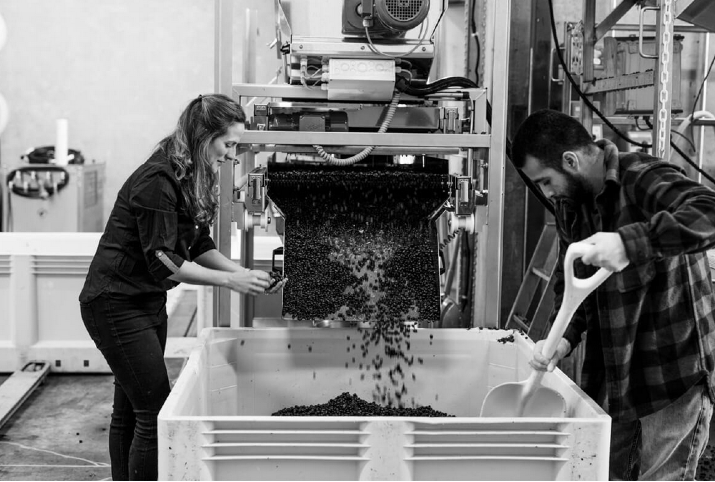
2019 Alma de Cattleya Sonoma Coast Pinot Noir 14.1% alc., pH 3.45, TA 0.63, RS 0.69 g/L, 2,000 cases, $30. Alma means “soul” in Spanish and Cattleya is the national flower of Colombia. Sourced equally from vineyards across the Sonoma Coast and Russian River Valley AVAs of Sonoma County. Clones 114, 115, 667, 777, Pommard, Wädenswil 2A and faux 828. 100% de-stemmed, short cold soak, fermented in stainless steel open-top tanks, hand punch-downs, aged 16 months in French oak barrels. DIAM cork closure. Score: 90
2019 Cattleya Cuvée Number One Russian River Valley Pinot Noir 14.2% alc., 350 cases, $60. Part of the Appellation Series.The name reflects Bibiana’s first AVA blend under Cattleya Wines. Crafted from small, individual row selections of two Russian River Valley vineyards located in the Green Valley and Santa Rosa Plain subdivisions of the AVA. 42% clone 115, 28% Pommard, 21% 777, and 9% 667. 100% de-stemmed, native primary fermentation in stainless steel open-top tanks following 10 days of cold soak. Gentle punchdowns by hand. Aged in French oak barrels, 45% new. Bottled unfined and unfiltered. · Moderate garnet color in the glass. Very bright aromas of ripe strawberry, black cherry and baking spices upon opening. Refined and elegant, yet packed with black cherry and ollaliberry fruit flavors with a black tea and cola note in the background. Modest tannins, with a tangy, moderately long finish. Score: 94
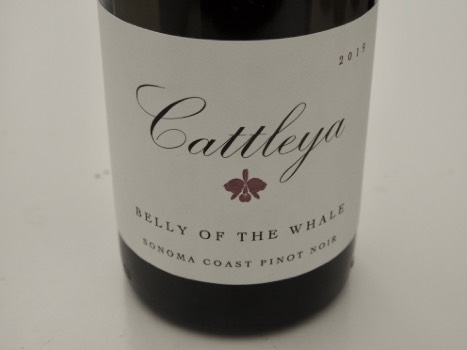 2019 Cattleya Belly of the Whale Sonoma Coast Pinot Noir 14.5% alc., 250 cases, $75. Part of the Collection series. 50/50 clones 777 and 667 at Sun Chase Vineyard , perched at an elevation of 2,300 feet above the cool maritime fog layer and overlooking western Sonoma County. Slow, methodical hand-sorting, 100% de-stemmed, native fermentation in opentop stainless steel tanks, hand punch-downs twice daily. Aged 10 months in 50% new French oak barrels. Bottled without fining or filtration. · Whoa, Nelly! Moderately dark garnet color in the glass. Lovely and engaging aromas of black cherry, rose petal, spice, pipe smoke and tilled earth. Mid-weight plus in style with a luscious core of black cherry fruit embellished with clove and cardamom spices. Gentle power, with terrific flow and balance with an extremely long finish. Delightful in every way. Still terrific when tasted the following two days from a previously opened bottle. Score: 96
Clarice & Beau Marchais: Winemaker Adam Lee’s Newest Ventures
Responding to the many challenges of balancing work and family, Adam sold Siduri Wines in 2015 to Jackson Family Wines, freeing him from the business side of the winery and allowing time to continue as the consulting winemaker. The sale also gave him time to launch new projects. One of the new projects is Clarice Wine Company, an innovative approach to winery ownership that combined a subscription-based Pinot Noir wine lineup with the opportunity for the subscriber group to become actively involved in an educational experience offered by Adam. Her created a completely new consumer experience for an extended wine family that offered more benefits than the typical mailing list or wine club. I first wrote about Clarice Wine Company here: www.princeofpinot.com/article/2040/. Clarice Pinot Noir is sourced from two special sections of Garys’ Vineyard and Rosella’s Vineyard in the Santa Lucia Highlands. This choice stems from Adam’s long term working relationship with growers Gary and Mark Pisoni and Gary Franscioni. Grapes are picked from all sections at the same time so that there is variability in grape ripeness. The hope is that this unusual approach will result in wines of more complexity. A high percentage of whole clusters are included in the fermentation at the bottom of the stainless steel fermenting tanks and de-stemmed berries are added on top. Indigenous yeast and indigenous malolactic bacteria are used for all ferments. The wines are bottled unfined and unfiltered. Inquiries about details and subscribing to Clarice Wine Company can be obtained at www.claricewinecompany.com.
2018 Clarice Santa Lucia Highlands Pinot Noir 14.1% alc., pH 3.70, TA 0.62, screw cap. A blend of fruit from Garys’ Vineyard (63%) and Rosella’s Vineyard (37%). 78% whole cluster fermented. Indigenous primary and malolactic fermentation. Aged in 37.5% French oak barrels. · Moderately light garnet color in the glass. Aromas of dark cherry, ripe strawberry and brioche lead to a mid-weight styled wine with good length of flavors that include ripe strawberry and black cherry. A solid wine with welcoming juicy acidity, a winning silky texture and buried tannins, only lacking in finishing impact. Score: 91
2018 Clarice Rosella’s Vineyard Santa Lucia Highlands Pinot Noir 14.4% alc., pH 3.64, TA 0.64, screw cap. 20% of juice was bled off at the time of cold soak. 81% whole cluster fermented, indigenous primary and malolactic fermentation, aged in 73% new French oak barrels. · Moderately dark garnet color in the glass. Appealing aromas of dark berries, spice drawer, new leather and warm brioche. Noticeable freshness in a middleweight style with flavors of black cherry, boysenberry and a hint of mocha. Lithe tannins with upbeat acidity and a thirst quenching finish. Score: 92
2018 Clarice Garys’ Vineyard Santa Lucia Highlands Pinot Noir 14.08% alc., pH 3.64, TA 0.59, screw cap. 76% whole cluster fermented. 7-day cold soak (during which time 20% of the juice was bled off to concentrate the must), indigenous primary and malolactic fermentation. Aged in 73% new French oak barrels. Bottled without fining or filtration. · Moderately dark garnet color in the glass. Pleasing aromas of black raspberry, boysenberry and strawberry tart. A typical Garys’ Pinot Noir with oodles of deeply-flavored black cherry, black raspberry and blackberry fruits framed by soft, non-aggressive tannins. Less acid, but more power and structure than the Rosella’s wine. Sleek and comforting in the mouth with a robust and lengthy finish. Score: 93
Adam has spent time in the Chateauneuf-de-Pape region of France and became friends with Philippe Cambie who crafts wines from this region under the Les Halos de Jupiter label. Philippe consults for numerous wineries throughout the south of France as well as Washington State and California. Adam and Philippe decided to join together to produce transformational Pinot Noir. they chose the name, “Beau Marchais” for their winery. Loosely translated, it means “Beautiful Walking.” Pierre Beaumarchais was a French playwright, inventor, musician, spy and more and was one of the strongest supporters of France’s involvement on the side of the Colonists during the American Revolution. So an American and a Frenchman now walk together to promote something they both believe in.
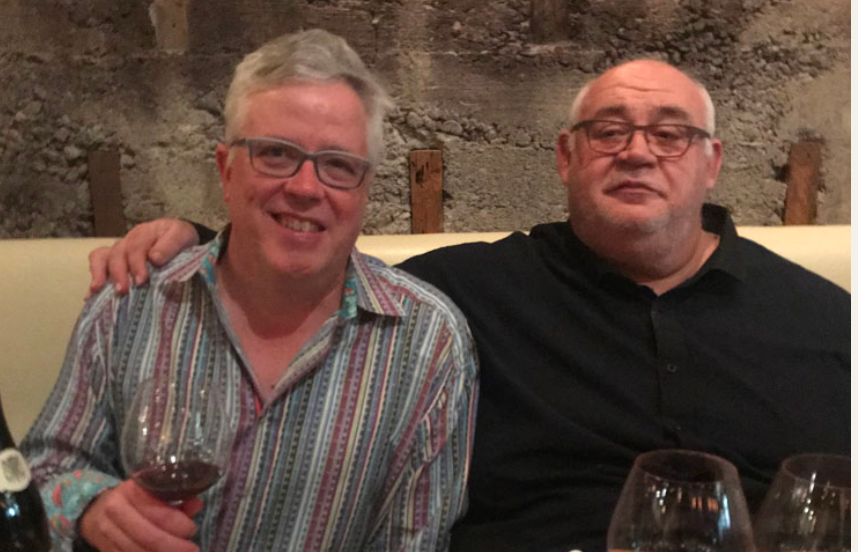 Winemaking is a long-distance affair with Adam doing the ground work in Healdsburg, California, and Philippe offering remote instruction from France. The concluding blending is done with the collaborators tasting together in person. The twist is that Beau Marchais Pinot Noir is Pinot Noir made in the style of Chateauneuf Grenache. The grapes are picked relatively early, about 25% whole cluster fermentation is employed (compared to about 80% for Clarice), and an enzyme is used during cold soak to extract more character and tannin from the skins. The wine undergoes extended maceration on the skins for about 48 days which is unheard of for domestic Pinot Noir. Barrel choices are totally new for Adam and there is a relatively high amount of new oak. The Pinot Noir wines offered are composed of fruit from Soberanes Vineyard in the Santa Lucia Highlands and Clos Pepe Vineyard in the Sta. Rita Hills. The inaugural 2019 vintage wines became available in November 2020. The wines are available on the winery’s website at wwws.beaumarchaiswine.com. Prices include shipping in the US. Beau Marchais wines are made available to subscribers to Clarice Wine Company as well. I felt like a fish out of water tasting and reviewing these three Pinot Noirs which are unlike any domestic Pinot Noir. My experience in tasting Rhone wines is nonexistent since the 1980s so you can take my words with that background in mind. Honestly, I did not particularly enjoy these wines as a Pinot Noir purist and found them very difficult to score. But, my lack of appreciation should not dissuade you if you are adventurous and have a liking for Grenache, so by all means give them a try.
2019 Beau Marchais Clos Pepe Vineyard Est (East) Sta. Rita Hills Pinot Noir 15.1% alc., $95. From an eastern edge and middle of the vineyard that are protected. Clones 115 and Pommard. · Moderate garnet color in the glass. Complex nose offering aromas of blackberry, cassis, violets, blueberries, underbrush, oak spice and sweet pipe smoke. Mid-weight plus in heft with flavors that replicate the aromas with added tastes of plum, tar and spice. Big-boned, yet sleek in texture. Infused with plenty of felty, dry tannins that contribute some astringency to the long finish. The alcohol is well positioned in the overall balance. A tasting of the wine the following day from an opened bottle required some coaxing in the glass to reveal itself. Score: 91
2019 Beau Marchais Clos Pepe Vineyard Quest (West) Sta. Rita Hills Pinot Noir 15.1% alc., $95. From a cooler parcel of the vineyard facing the Pacific Ocean and its strong wind.. Pommard and 667 clones. 33% whole cluster. Extended maceration of 48 days. · Moderately dark garnet color in the glass. Leading off are aromas of blackberry, blueberry, pomegranate, tilled earth and seasoned oak. Mid-weight plus in style, packed with a dense core of purple and black fruits that are a bit unyielding at this point. A floral note adds charm. Showing a little more oak and tannin than the East bottling but with a flood of fruit on a longer finish. This wine offers more nuances and I found more appealing than the East bottling. Surely this wine will benefit from a couple of years in the cellar. Score: 93
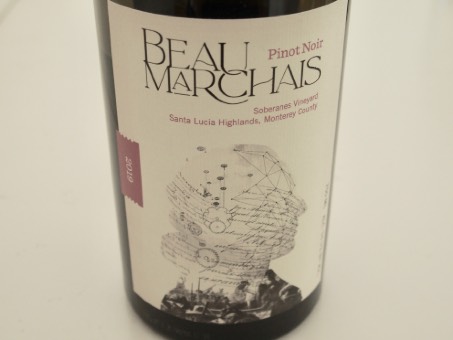 2019 Beau Marchais Soberanes Vineyard Santa Lucia Highlands Pinot Noir 15.1% alc., $95 · Dark garnet color in the glass. The most aromatic of this trio of wines, offering invigorating aromas of black cherry, black raspberry, spice and purple rose petal. Full-bodied and stacked and packed with fruit but light on its feet. The fruit seems less ripe than in the Clos Pepe bottlings and is more spirited and charming.. The tannins are well balanced, the alcohol is not apparent and the dry, long finish is gratifying. This wine is the most approachable of the three 2019 wines tasted and more pinot-typical. Score: 94
Darling Wines
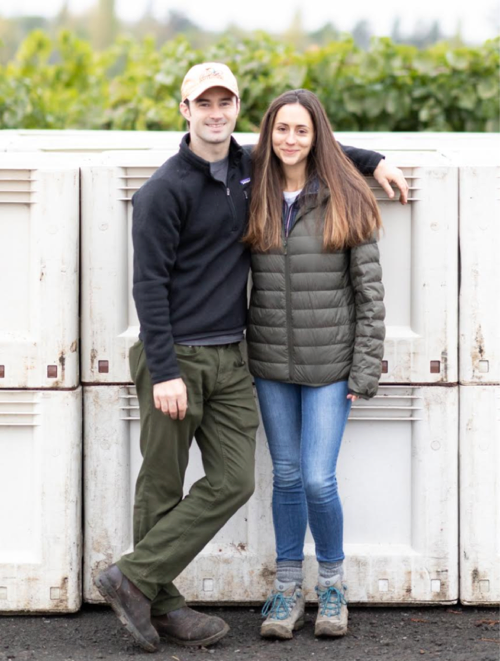 Darling Wines expanded to Pinot Noir and Chardonnay with the 2018 vintage. The couples’ inspiration has been the wines from Kutch, Drew Family Cellars, and COBB Wines among others. Winemaking starts with harvesting balanced fruit so no adjustments are required in the winery, touching the wine as little as possible throughout the process. The only addition to Darling wines is small amounts of sulfur (below 40ppm total). All three of the Darling 2018 wines were featured at the Restaurant at Meadowood and the 2018 Azaya Pinot Noir and McEvoy Ranch Syrah were on the wine list at The French Laundry, as well as other great restaurants in the Bay Area. Tom told me, “The Darling style seems to work well on the table as the wines have bright natural acidity, minimal to no new oak, and moderate alcohol percentages.” The whole cluster character of the wines reviewed here is upfront so these wines will be most appealing to those who savor whole cluster infused aromas and flavors in Pinot Noir. Tom has clearly been inspired by the style of those producers mentioned.
Darling wines are available at www.darlingwines.com/shop.
2019 Darling Azaya Vineyard Petaluma Gap Marin County Pinot Noir
12.5%
alc., 100 cases, $48. Released November 1, 2020. This certified organic vineyard
was planted in 2006 at 420 feet above sea level. in Blucher loam. Double sorted,
vineyard and winery. 75% whole cluster. Combination of gentle pump-overs, foot
treading and punchdowns. Native primary fermentation, native MLF and aged 10
months in neutral oak. Bottled unfined and unfiltered.
·
Moderate garnet color in the
glass. Lovely, deep aroma of dark cherries with whole cluster undertones. Midweight
in character, infused with spirited acidity, and framed by moderate tannins,
this wine delivers an expansive mid palate of cherry goodness, finishing with some
length and spirit. There is a noticeable stamp of tobacco, presumably from stem
tannins.
Score: 91
2019 Darling Grand Vent Vineyard Petaluma Gap Pinot Noir
12.6% alc., 100 cases, $60. Released
February 1, 2021. This vineyard, which is exposed to dense marine fog and relentless wind making it a
challenging cool-climate site to farm. It was planted in 2000 at 270 feet elevation. Soil is Steinbeck loam. Hand
farming is organic. 100% whole cluster, native yeast primary fermentation, native MLF, aged 10 months in
neutral oak. Bottled unfined and unfiltered.
·
Moderate garnet color in the glass. The nose is imbued with whole
cluster imprint, offering aromas of cherry, exotic spices, burnt tobacco, rose petal and a touch of barnyard.
Light to mid-weight in style, offering flavors of cherry, raspberry and boysenberry with a burnt tobacco-ash
stamp that threatens to obscure the wine’s nuances. Unchanged when tasted the following day from a
previously opened bottle.
Score: 90
Bluebird Hill Cellars
Once the land was cleared, grapevine planting ensued. There are currently 3 acres under vine with Dijon clones, Wadenswil clone, and Pommard clone all planted at a high density. The wines from Bluebird Hill are produced in small lots, using a combination of traditional and modern winemaking techniques with a focus on detail. The Pinot Noir wines are aged for a full two years in barrel prior to bottling and the Reserve wines are bottled unfined and unfiltered. The winery’s website is at www.bluebirdcellars.wine. Call 541-424-2478 to order wine. The tasting room is currently open only for bottle sales and curbside pickup through April 2021. The beautiful labels were designed by local artist Sky Evans. br> 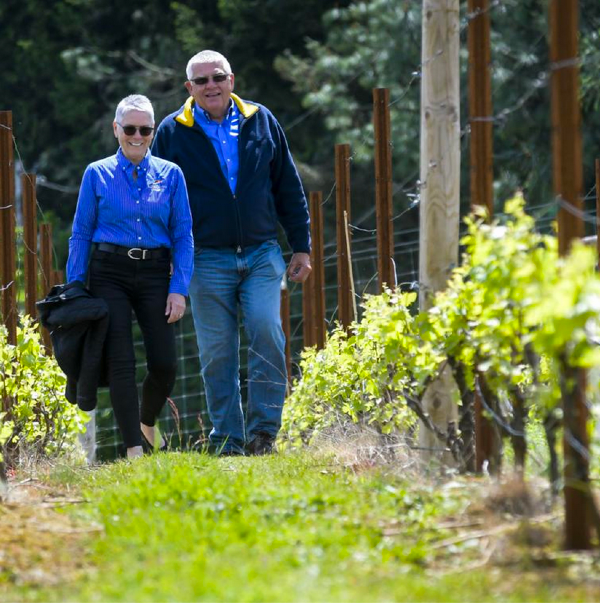
2018 Bluebird Hill Cellars Willamette Valley Pinot Noir 14.2% alc., pH 3.75, RS 0 g/L, 175 cases, $32. Harvest Brix 23.1º. 85% Bluebird Hill Vineyard, 15% Zenith Vineyard. Aged in French oak barrels, 18% new. · Moderately light garnet color in the glass. The nose offers aromas of cherry, espresso, graham and spice. Lighter in style, with a charming core of dark red cherry and berry fruits touched by flavors of red licorice and baking spices. Easygoing and easy to like, with modest tannins and a cherry-fueled finish. Score: 89
2018 Bluebird Hill Cellars South Block Reserve Willamette Valley Pinot Noir 13.5% alc., pH 3.71, RS 0 g/ L, 75 cases, $49. 100% Bluebird Hill Vineyard. Harvest Brix 23.2º. Aged in French oak barrels, 10% new. · Moderately light garnet color in the glass. Nicely perfumed with aromas of dark red raspberry and cherry, earthy flora and sandalwood. Light to mid-weight in style, with an elegant array of dark red and purple fruits accented with spice and vanilla. Silky on the palate, integrated fine tannins, and overall a joyous drink. Score: 93
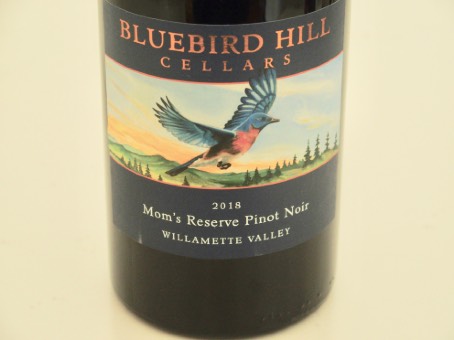 2018 Bluebird Hill Cellars Mom’s Reserve Willamette Valley Pinot Noir 14.2% alc., pH 3.60, 83 cases, $49. 100% Bluebird Hill Vineyard. Harvest Brix 21.3º-22.8º. Aged in French oak barrels, 10% new. · Moderately light garnet color in the glass. Shy aromas of black cherry and raspberry. More appealing on the palate with a middleweight charge of black cherry, blackberry, spice and floral flavors. The fruit definitely veers to the ripe side. Somewhat boldly flavored yet refined and polished with decent length on the finish. The nose continued to be reserved but pleasant when tasted the following day from a previously opened bottle. Score: 91
2018 Bluebird Hill Cellars Zenith Vineyard Reserve Willamette Valley Pinot Noir 14.3% alc., pH 3.72, RS 0 g/L, 50 cases, $49. 100% Zenith Vineyard. Harvest Brix 22.3º. Aged in French oak barrels, 15% new. · Moderate garnet color in the glass. Reticent aromas of cherry, baking spice and cocoa. An aldehyde-driven note of candied apple blows off with time.The light to mid-weight essence of fresh, dark red cherry is framed by modest tannins. The wine picks up richness of flavor by the following day when re-tasted from a previously opened bottle. Score: 90
Women Pinot Noir Winemakers
We probably shouldn’t be even talking bout women winemakers of Pinot Noir as if they were a different species. The discussion of any Pinot Noir starts with what is in the bottle or the glass, only secondarily moves to a discourse on who produced the wine. Female winemakers prefer to be called winemakers just like it makes no sense for men to be called men winemakers. Women have a touch with Pinot Noir and here are some winemakers to seek out.
California
Abiouness: Nicole Abiouness *Alma Rosa Winery & Vineyards: Samra Morris *Anaba Wines: Katy Wilson Artesa Vineyards & Winery: Ana Diogo-Draper *Banshee Wines: Alicia Sylvester *Bacigalupi VineyardsL Ashley Herzberg Bennett Valley Cellars: Toni Stockhausen *Blagden Wines: Catherine Blagden *Bogle Vineyards: Dana Stemmler *Bouchaine Vineyards: Chris Kajani *Bruliam: Kerith Overstreet *Bryter Estates: Kari Auringer *Cakebread Cellars: Stephanie Jacobs *Cambria Estate Vineyard & Winery: Denise Shurtleff, Jill DelaRiva Russell *Carol Shelton Wines: Carol Shelton Casa Carneros: Melissa Moravac Casa Dumetz: Sonja Magdevski *Castle Rock Winery: Meghan Rech Cattleya and Alma de Cattleya: Bibiana Gonzalez Rave *Chateau St. Jean Winery & Vineyards: Margo Van Staaveren *Cuvaison Estate Wines: Sally Nightingale D. Volk Wines: Dana Volk Dalfonso-Curran Wines: Kris Curran *De La Montanya Estate Vineyards & winery: Tami Collns *Dehlinger Winery: Eva Dehlinger Derbes Wines: Cecile Lemerle-Derbes Ektimo Vineyards: Lisa Bishop Forbes *El Molino: Lily Oliver Berlin *Ferrari-Carano: Sarah Quider, Rebecka Deike *Fiddlehead: Kathy Joseph Flowers Vineyards & Winery: Chantal Forthun Francis Ford Coppola Winery: Andrea Furber Card *Freeman Vineyards & Winery: Akiko Freeman Gallo Signature Series: Gina Gallo Garnet Vineyards: Alison Crowe *Gary Farrell Winery & Vineyards: Theresa Heredia *Greenwood Ridge Vineyards: Victoria Wilson *Hirsch Vineyards: Jasmine Hirsch Horse & Plow: Suzanne Hagins (formerly Lutea) *Inman Family Wines: Kathleen Inman *J Vineyards & Winery: Nicole Hitchcock Joel Gott Wines: Alisa Jacobson, Chelsea Barrett, Sarah Gott *Ketcham Estates Winery: Tami Collins *Kitá: Tara Gomez Kynsi Winery: Gwen Othman *La Rue: Katy Wilson LaMontagne Winery: Kimberly Smith Land of Promise: Diana Karren *Lazy Creek Vineyards: Christy Ackerman Lincourt Wines: Lorna Kerutz *LOBO Wines: Victoria Coleman Lucas & Lewellen: Megan McGrath Gates *Lumen Wines: Lane Tanner *MacRostie Winery & Vineyards: Heidi Bridenhagen *Maggy Hawk: Sarah Wuethrich Marcassin: Helen Turley *Martin Ray Vineyards & Winery: Leslie Mead Renaud *Martinelli: Courtney Wagoner, Erin Green *Matrix Winery: Diane Wilson, Victoria Wilson *Merry Edwards Wines: Heidi Von Der Mehden Metzker Family Estates: Melissa Apter Castro *Migration: Dana Epperson Miner Family Winery: Stacy Vogel Mojave Wines: Rebecca George *Neely: Shalini Sekhar Niner Wine Estates: Molly Bohlman *Oakwild Ranch Toboni Vineyard and Kastania Vineyards: Leslie Sisnerot *Onward Wines: Faith Armstrong-Foster Pahlmeyer: Jennifer Williams *Peake Ranch Vineyard: Wynne Solomon *Peay Vineyards: Vanessa Wong *Pfendler Vineyards: Erica Stancliff Riverbench Winery & Vineyard: Clarissa Nagy Robert Mondavi Winery: Megan Schofield Sapphire Hill: Tami Callins Scheid Vineyards: Marta Kraftzeck School House Vineyard: Sally Johnson *Seagrape Wine Company: Karen Steinwachs Selby Winery: Susie Selby Shannon Ridge Family of Wines: Annette Hoff Danzer Shokrian Vineyard: Morgan Clendenen Simi Winery: Melissa Stackhouse (previously La Crema, Jackson Family Wines, J Vineyards & Winery, Meiomi) *Sonoma-Cutrer Vineyards: Zidanelia Arcidiacono Stolo Family Vineyards: Nicole Pope Storrs Winery: Pamela Storrs *Taft Street Winery: Melissa Kuhn *Tessier: Kristie Tacey Tolay Springs Winery: Julia Iantosca *Trombetta Family Wines: Erica Stancliff Truett Hurst Winery: Virginia Lambrix *Tulocay Winery: Brie Cadman Valdez Family Winery: Elizabeth Valdez *Waits-Mast Family Cellars: Shalini Sekhar *WALT: Alison Frichtl Hollister, Megan Paredes Gunderson *WesMar: Denise Hubbard Selyem *Wonderment Wines: Stephanie Cook *Wrath: Sabrina Rodems
Oregon
*A to Z Wineworks: Cheryl Francis *Airlie Winery: Elizabeth Clark *Adelsheim Vineyard: Gina Hennen *Analemma Wines: Kris Fade *Anne Amie Vineyards: Gabriela Sepulveda Vignes *Antica Terra: Maggie Harrison Archery Summit Winery: Anna Matzinger Ardiri Wine: Gail Lizak Björnson Vineyard: Pattie Björnson Boedecker Cellars: Athena Pappas Coleman Vineyards: Kim Coleman Day Wines: Brianne Day *De Ponte: Isabelle Dutarte *Domaine Drouhin Oregon: Veronique Drouhin-Boss *Domaine Serene: Rachel Zasadni (long-time assistant) *Et Fille Wines: Jessica Mozeico Eunice Chiweshe Goldstein Winery: Eunice Chiweshe Goldstein Geodesy: Magan Baccittich *Ghost Hill Cellars: Rebecca Pittock-Shouldis HelioTerra: Anne Hubatch Hip Chicks Do Wine: Renee Neely and Laurie Lewis Honeywood Winery: Marlene K. Gallick *Jackson Family Wines: Eugenia Keegan *Kelley Fox Wines: Kelley Fox *Kramer Vineyards: Kimberly Kramer Lavinea: Isabelle Meunier *LUMOS: Julia Cattrall Matzinger Davies Wines: Anna Matzinger *Maysara Winery*: Tahmiene Momtazi Omero Cellars: Sarah Cabot OO Wines: Wynne Peterson-Nedry *Ponzi: Louisa Ponzi *Phelps Creek: Alexandrine Roy *Privé Vineyard: Piper Underbrink *Penner-Ash Wine Cellars: Lynn Penner-Ash Quarantine Wine: Sarah Cabot Ransom: Julia Cattrall Redman Vineyard & Winery: Cathy Redman Ridgecrest Wines: Wynne Peterson-Nedry RR Wines: Wynne Peterson-Nedry *Stoller Family Estate: Kate Payne-Brown, Melissa Burr Stone Wolf Vineyards: Linda Lindsay Stoney Wines: Donna Stoney Southeast Wine Collective and Divison Wine Company: Kate Norris Sweet Cheeks Winery: Lorrie Normann *Tyee Cellars: Merrilee Buchanan Union Wine Company: Meredith McGough, Joanna Engel *Westrey Wine company: Amy Wesselman *Willamette Valley Vineyards: Christine Clair *Willful Wine Co.: Pam Walden *Winter’s Hill Vineyard: Delphine Gladhart
Founded in 2019, Women in Wine: Fermenting Change was Oregon’s first event dedicated to advancing women in the wine industry. The 2021 Women in Wine Conference Virtual Gathering is Scheduled for July 19, 2021
Briefs
Dietary Fats Interact with Grape Tannins to Influence Wine Taste An article appeared March 3, 2021, in ACS’ Journal of Agricultural and Food Chemistry in which researchers concluded that tannins in wine can interact with oil droplets in the mouth, making them less available to bind to saliva proteins and cause astringency. This is why eating cheese along with a tannic wine reduces the astringency of the wine. Schug Carneros Estate Winery Marks 40th Anniversary In my early years of dalliances with Pinot Noir, I drank many bottles of Schug Pinot Noir. Walter Schug, who passed away in 2015, has left a legacy kept alive by his children and a new, young German-American winemaker. Schug focuses on Pinot Noir and Chardonnay from its Carneros estate as well as partner vineyards elsewhere in Carneros and the Sonoma Coast. The new winemaker, Johannes Scheid had his debut with the 2019 vintage at Schug. Axel Schug and his sister Claudia now guide the operations of the 30,000-case winery. The Schug Carneros Estate Winery is open to visitors by appointment Thursday through Sunday for wine tasting and cave tours. Visit www.schugwinery.com for more information. World of Pinot Noir Silent Auction The auction is now live and will run throughout the month of March 2021. This is primarily a large-format Pinot Noir auction. Register to bid via your desktop or mobile phone at www.worldofpinotnoir.com/auction/. “Little” Pisoni Pinot Noir The Pisoni family and Master Sommelier Sara Floyd have teamed to produce two new releases under the Luli label, both just 100 case production. The wines were sourced from the 15-acre Monte Linda Vineyard and 26-acre Lemoravo Vineyard, both located in the Santa Lucia Highlands. The two wines, priced at $41.99, are now available at www.goldengatewinecellars.com.
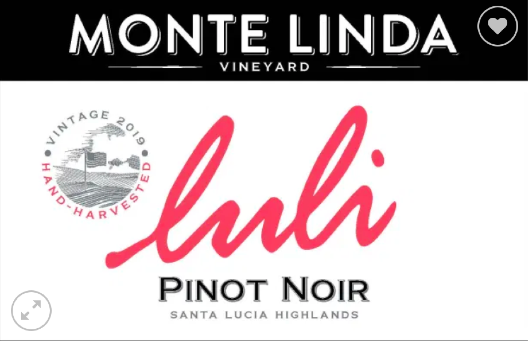 |
